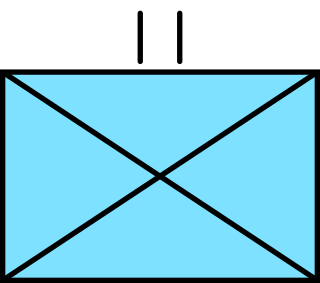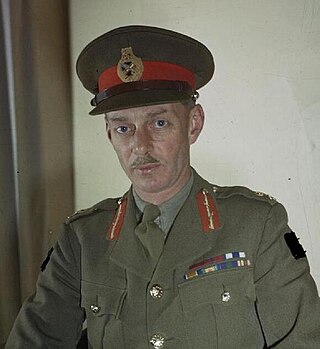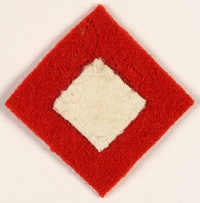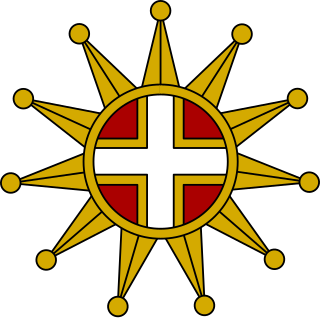Related Research Articles

A battalion is a military unit, typically consisting of up to one thousand soldiers commanded by a lieutenant colonel and subdivided into a number of companies, each typically commanded by a major or a captain. The typical battalion is built from three operational companies, one weapons company and one headquarters company. In some countries, battalions are exclusively infantry, while in others battalions are unit-level organisations.

A brigade is a major tactical military formation that typically comprises three to six battalions plus supporting elements. It is roughly equivalent to an enlarged or reinforced regiment. Two or more brigades may constitute a division.
Corps is a term used for several different kinds of organization. A military innovation by Napoleon I, the formation was first named as such in 1805. The size of a corps varies greatly, but two to five divisions and anywhere from 40,000 to 80,000 are the numbers stated by the US Department of Defense.

I Corps was an army corps in existence as an active formation in the British Army for most of the 80 years from its creation in the First World War until the end of the Cold War, longer than any other corps. It had a short-lived precursor during the Waterloo Campaign. It served as the operational component of the British Army of the Rhine during the Cold War, and was tasked with defending West Germany.
Captain general is a high military rank of general officer grade, and a guvernatorial title.
A group is a military unit or a military formation that is most often associated with military aviation.

The 4th Canadian Division is a formation of the Canadian Army. The division was first created as a formation of the Canadian Corps during the First World War. During the Second World War the division was reactivated as the 4th Canadian Infantry Division in 1941 and then converted to armour and redesignated as the 4th Canadian (Armoured) Division. Beginning in 1916 the division adopted a distinctive green-coloured formation patch as its insignia. In 2013 it was announced that Land Force Central Area would be redesignated 4th Canadian Division. It is currently responsible for Canadian Army operations in the Canadian province of Ontario and is headquartered at Denison Armoury in Toronto.

III Corps was an army corps of the British Army formed in both the First World War and the Second World War.

An Army Group Royal Artillery (AGRA) was a British Commonwealth military formation during the Second World War and shortly thereafter. Generally assigned to Army corps, an AGRA provided the medium and heavy artillery to higher formations within the British Army.

General Sir Miles Christopher Dempsey, was a senior British Army officer who served in both world wars. During the Second World War he commanded the Second Army in northwest Europe. A highly professional career soldier who made his reputation in active service, Dempsey was highly thought of by both his subordinates and superiors, most notably Bernard Montgomery, but is not well known.
Colonel commandant is a military title used in the armed forces of some English-speaking countries. The title, not a substantive military rank, could denote a senior colonel with authority over fellow colonels. Today, the holder often has an honorary role outside the executive military structure, such as advocacy for the troops.

The 5th Indian Infantry Division was an infantry division of the Indian Army during World War II that fought in several theatres of war and was nicknamed the "Ball of Fire". It was one of the few Allied divisions to fight against three different armies - the Italian, German and Japanese armies.

The 8th Armoured Division was an armoured division of the British Army during the Second World War. It was deployed to Egypt in June 1942 but never operated as a complete formation and was disbanded in January the following year.

The 11th Security Force Assistance Brigade is a brigade of the British Army which is intended to train and assist foreign forces. In 2021, under the Future Army changes, the brigade was redesignated, formerly being the 11th Infantry Brigade & HQ South East. Prior to the Army 2020 changes in 2013, the brigade was temporarily activated for deployment to Afghanistan. Originally formed in the Second Boer War, the brigade was engaged during both World Wars.

The 42nd Armoured Division was an armoured division of the British Army raised during the Second World War.

The 25th Indian Infantry Division was an infantry division of the Indian Army during World War II which fought in the Burma Campaign. It was re-raised within the post-independence Indian Army in 1948.

XI Corps was a corps-sized formation of the British Expeditionary Force, active during the First World War that served on the Western Front and in Italy. It was recreated as part of Home Forces defending the United Kingdom during the Second World War.

Major-General Sir Stephen Cyril Ettrick Weir, was a New Zealand military leader and diplomat.

The 1st Anti-Aircraft Division was an Air Defence formation of the British Army before and during the early years of the Second World War. It defended London during the Battle of Britain and The Blitz.
59th Army Group Royal Artillery was an artillery formation of the British Army in World War II. Having operated in the North West Europe theatre in late 1944, it was switched to India to command artillery units preparing for the liberation of South-East Asia.
References
- ↑ "Commander, Royal Artillery". Canadian soldier. Archived from the original on 26 September 2007.
- ↑ "Headquarters, Commander, Royal Artillery". RA39-45. Retrieved 13 October 2024.
- ↑ "North West Europe 1944–1947: British Artillery Formations". British Military History. Retrieved 13 October 2024.